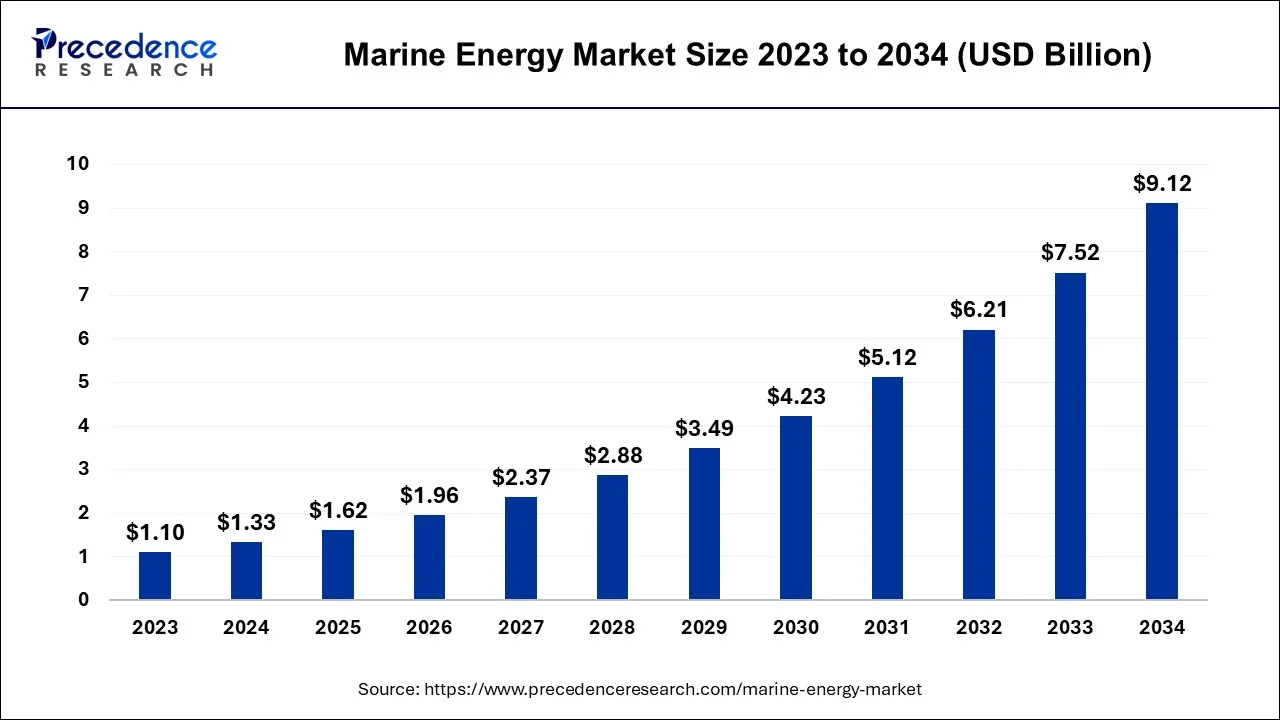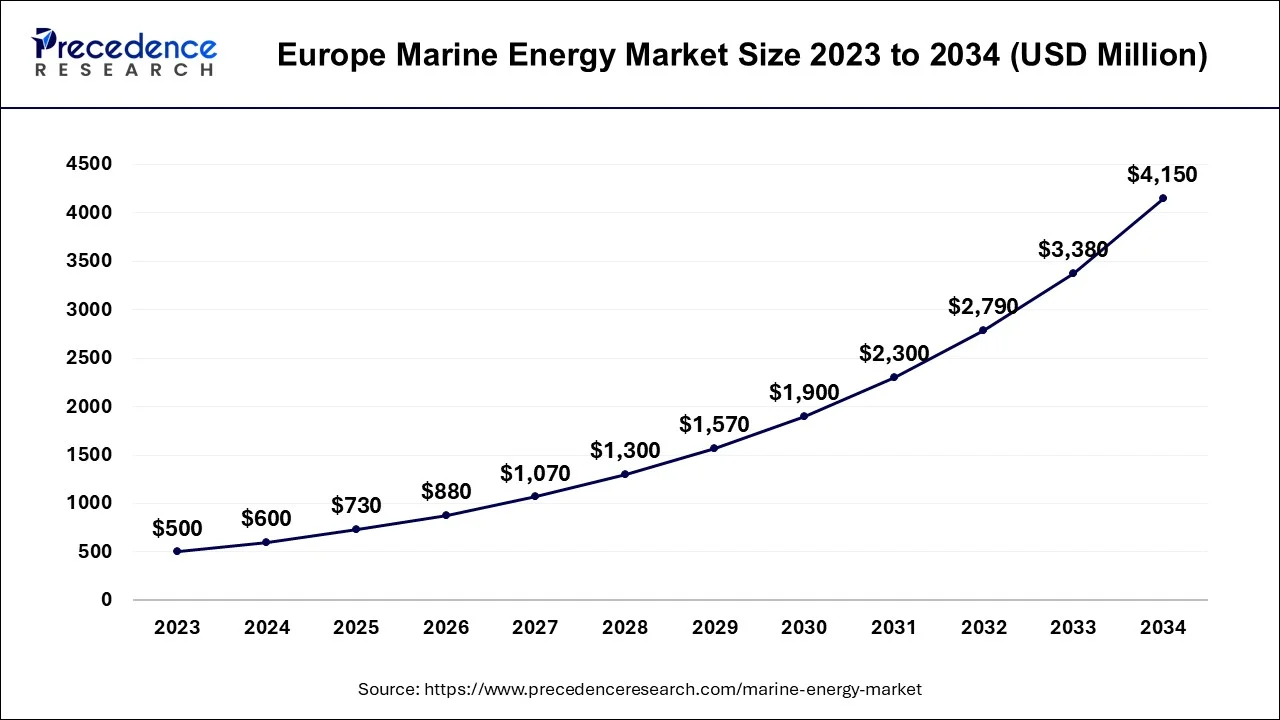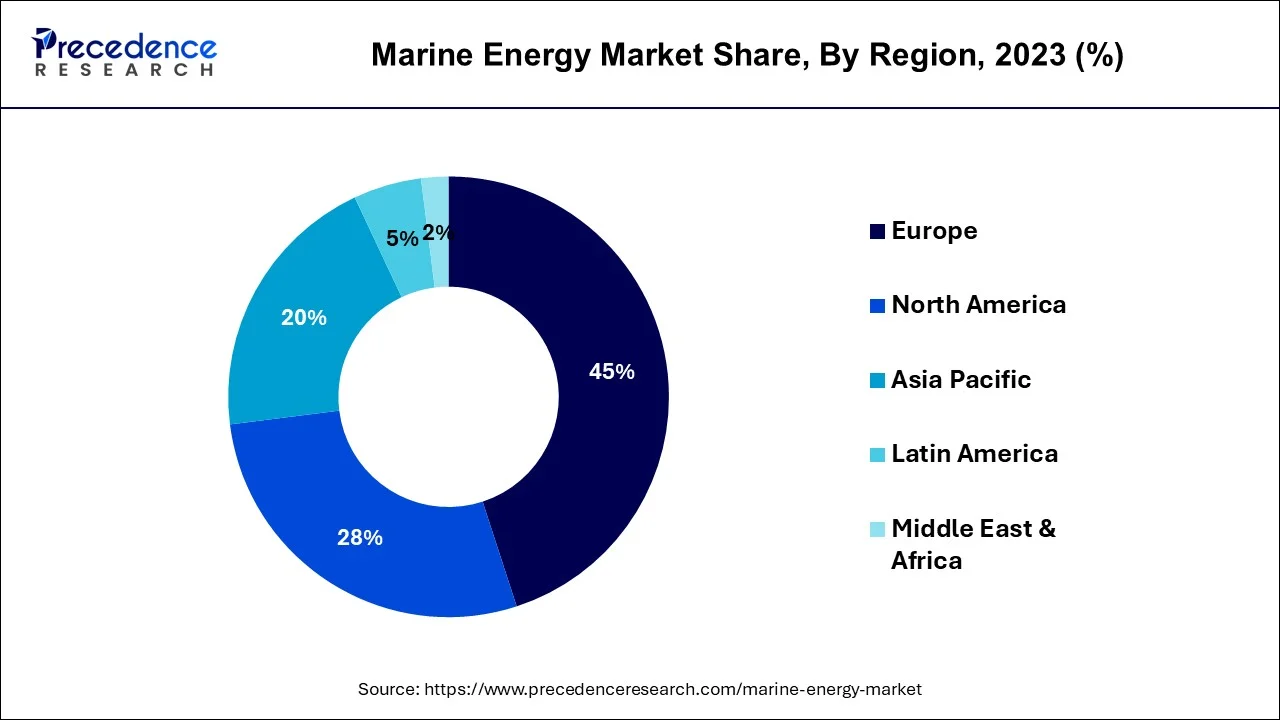February 2025
The global marine energy market size is estimated at USD 1.33 billion in 2024, grew to USD 1.62 billion in 2025 and is predicted to surpass around USD 9.12 billion by 2034, expanding at a CAGR of 21.20% between 2024 and 2034.
The global marine energy market size accounted for USD 1.33 billion in 2024 and is anticipated to reach around USD 9.12 billion by 2034, growing at a notworthy CAGR of 21.20% between 2024 and 2034.

The marine energy domain signifies the extraction of renewable energy sources originating from Earth's vast oceans and seas. It encompasses technologies such as tidal power, wave energy, and ocean thermal energy conversion (OTEC), all designed to generate electricity by harnessing the kinetic and thermal energy latent within marine waters. The market's expansion is propelled by the compelling demand for ecologically sound and sustainable energy solutions to counteract climate change and reduce the dependency on traditional fossil fuels.
The Europe marine energy market size ie estimated at USD 730 million in 2024 and is expected to reach USD 4,150 million by 2034, at a CAGR of 21.33% from 2024 to 2034.

Europe held the largest revenue share of 45% in 2023. Europe's significant share in the marine energy market is due to several key factors. It has a conducive policy environment with strong government support, subsidies, and regulatory frameworks promoting marine energy development. The continent has favorable oceanic conditions for various marine energy technologies, including wave and tidal energy.
Moreover, Europe has a well-established network of research institutions and industry players, fostering technological advancements. Collaborative projects and international partnerships have propelled the industry, making Europe a leader in marine energy innovation and deployment, thus securing a major share of the global market.

Asia Pacific is estimated to observe the fastest expansion. Asia Pacific is expected to witness prominent growth in the marine energy market for a variety of distinctive reasons. Its vast coastlines offer access to a rich spectrum of marine energy resources, including formidable tidal currents and potent oceanic waves. The regional governments have displayed notable dedication to the advancement of renewable energy and have enacted progressive policies and incentives to support the marine energy sector.
Moreover, the region's burgeoning energy demands, swift economic expansion, and the imperative for sustainable power sources in densely populated zones stimulate the adoption of marine energy solutions. Collaborative efforts with neighboring nations and innovative research endeavors further solidify Asia-Pacific as a dominant region in the global marine energy landscape.
| Report Coverage | Details |
| Growth Rate from 2024 to 2034 | CAGR of 21.20% |
| Market Size in 2024 | USD 1.33 Billion |
| Market Size by 2034 | USD 9.12 Billion |
| Largest Market | Europe |
| Base Year | 2023 |
| Forecast Period | 2024 to 2034 |
| Segments Covered | Type and Application |
| Regions Covered | North America, Europe, Asia-Pacific, Latin America, and Middle East & Africa |
Renewable energy demand
The flourishing of the marine energy market can be chiefly attributed to the escalating appetite for renewable energy sources. This surge in demand is due to convergence of compelling factors, including ecological imperatives, enhanced energy security, and the unyielding commitment to carbon emissions reduction.
Foremost, there exists a compelling demand to confront climate change, sparking a worldwide shift towards cleaner and more sustainable energy alternatives. Renewable energy, extracted particularly from the vast marine expanse, assumes a pivotal role in this transformation due to its intrinsic environmental merits, marked by its minuscule carbon footprint and gentle ecological impact.
Energy security also looms as a formidable motivator. As nations strive to diminish their dependence on fossil fuels, marine energy proffers a locally available resource that fortifies energy sovereignty. This broadening of the energy portfolio lessens vulnerability to global supply vagaries and price volatility. Additionally, the mandate to abate greenhouse gas emissions and attain ambitious sustainability objectives is galvanizing investments in renewable energy.
Marine energy seamlessly aligns with these aspirations, proffering a stable, unwavering source of clean power. In summation, the surging demand for renewable energy sources is propelling the burgeoning of the marine energy market, upheld by its eco-friendly, domestically accessible energy resource, firmly cementing its role as an indispensable cornerstone in the global quest for sustainable energy solutions.
Environmental impact assessment
Environmental Impact Assessment (EIA) serves as a significant restraint on the growth of the marine energy market. While essential for responsible and sustainable development, the rigorous EIA process imposes time-consuming and costly delays on project approvals. Marine energy projects must undergo extensive evaluations to assess their potential ecological consequences and mitigate any harm to marine ecosystems. These assessments often require substantial resources, both in terms of time and money, which can deter investors and increase overall project costs.
Furthermore, the uncertainty surrounding the outcome of EIA procedures can result in project setbacks and create a challenging environment for industry stakeholders. The need to strike a balance between environmental conservation and energy generation, while adhering to stringent regulatory requirements, poses a barrier to the timely and efficient expansion of the marine energy market.
Synergy with other industries
The synergy between the marine energy sector and other industries is creating significant opportunities within the market. Collaborative development with industries like aquaculture, fisheries, and maritime transport holds the potential to unlock mutual benefits. For instance, co-locating marine energy devices with aquaculture operations can lead to improved resource utilization, increased food production, and a reduction in environmental impacts. Similarly, integrating marine energy with fisheries can enhance the sustainability of fishing practices, boost economic gains for fishing communities, and mitigate potential conflicts over ocean space usage.
Furthermore, aligning marine energy projects with maritime transport hubs can facilitate the development of comprehensive energy infrastructure and support sustainable shipping operations, reducing greenhouse gas emissions in the process. These symbiotic relationships provide a unique avenue for innovation and the optimization of ocean resources, fostering economic growth, environmental stewardship, and technological advancement in the marine energy market.
Impacts of COVID-19
According to the type, the wave energy segment has held 38% revenue share in 2023. The prominence of the wave energy sector within the marine energy market can be attributed to its reliability and the widespread accessibility of this energy source across the globe. Wave energy stands out for its consistency and predictability, ensuring a stable energy supply.
Furthermore, the adaptability of wave energy systems allows for deployment in diverse oceanic regions, thereby capitalizing on the extensive energy potential present in the world's oceans. Ongoing technological innovations have enhanced the efficiency and economic viability of wave energy devices, rendering them an enticing choice for sustainable energy generation. This confluence of factors firmly establishes wave energy as a major contender within the marine energy market, significantly contributing to its substantial market share.
The salinity gradient power segment is anticipated to expand at a significantly CAGR of 21.2% during the projected period. Salinity Gradient Power (SGP) holds significant growth in the energy market due to its unique capacity to harness clean energy from the natural difference in salinity between saltwater and freshwater sources. This technology provides a reliable and consistent source of renewable energy, making it attractive for energy production.
Additionally, SGP offers a less intermittent and more predictable energy output compared to some other marine energy sources, contributing to its prominence. As the world seeks sustainable and innovative energy solutions, the ability of SGP to tap into this abundant resource positions it as a key player in the global renewable energy landscape.
Based on the application, the power generation segment is anticipated to hold the largest market share of 44% in 2023. Within the marine energy sector, power generation involves the utilization of oceanic resources, such as tidal movements, wave energy, and ocean currents, to generate electricity. This eco-friendly approach contributes to the reduction of fossil fuel dependence and offers a sustainable source of power. Recent developments in the marine energy market encompass technological progress and elevated investments in research and development.
Breakthroughs in tidal and wave energy technologies are enhancing their efficiency and dependability. Moreover, there is an increasing emphasis on seamlessly integrating marine energy into the broader renewable energy landscape, enhancing the overall sustainability of coastal power generation.
On the other hand, the others segment is projected to grow at the fastest rate over the projected period. The segment, encompassing industries like aquaculture and transportation, holds a substantial growth in the marine energy market due to symbiotic relationships and resource optimization. Co-location of marine energy devices with aquaculture operations improves resource utilization, increases food production, and reduces environmental impacts. Integration with maritime transport hubs supports sustainable shipping operations and enhances energy infrastructure. These collaborations offer mutual benefits, including economic gains, environmental stewardship, and technological innovation. The combined potential of these synergies has established the segment as a significant contributor to the marine energy market's growth and sustainability.
Segments Covered in the Report
By Type
By Application
By Geography
For inquiries regarding discounts, bulk purchases, or customization requests, please contact us at sales@precedenceresearch.com
No cookie-cutter, only authentic analysis – take the 1st step to become a Precedence Research client
February 2025
January 2025
January 2025
January 2025